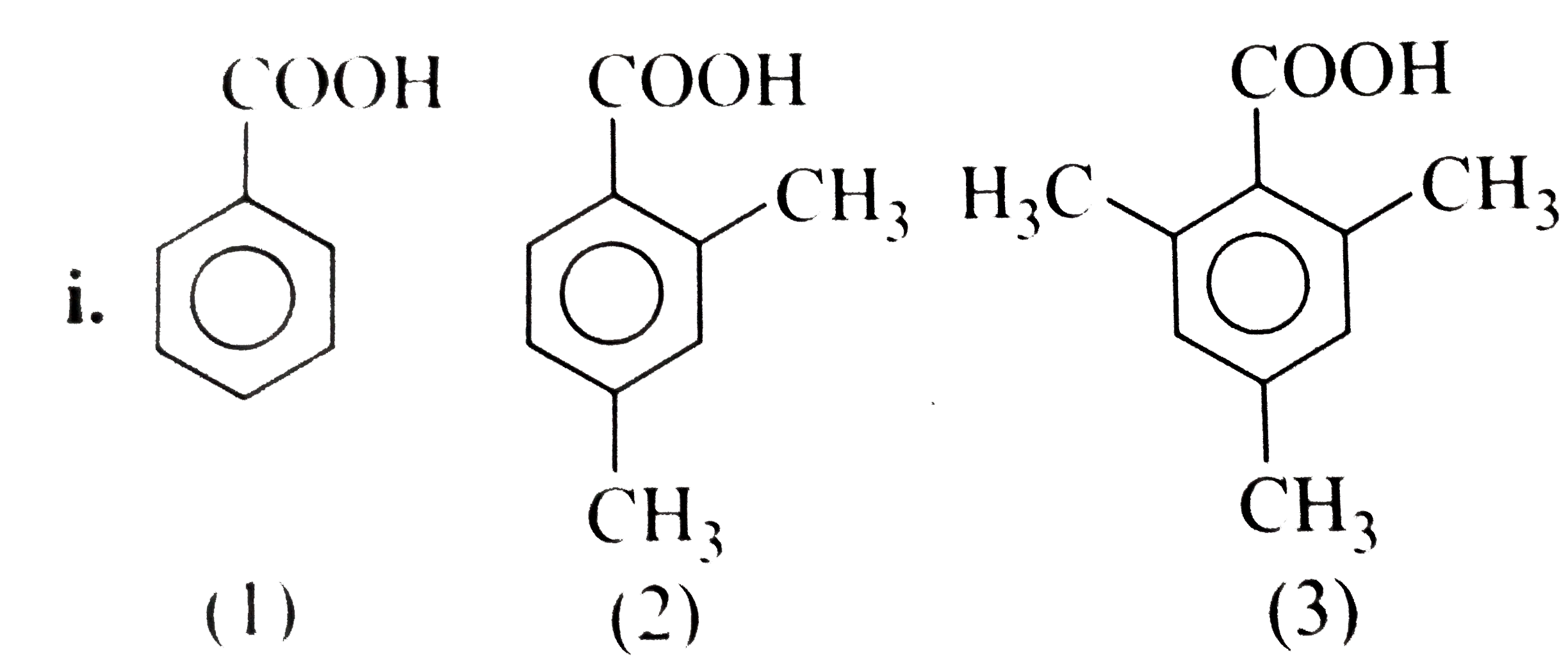Arrange in order of decreasing reactivity in electrophilic addition:
(I)PhCH=CHCOOH
(II)p−NO2−C6H4−CH=CHCOOH
(III)p−MeOC6H4CH=CHCOOH
(IV)p−C1C6H4CH=CHCOOH
II>I>IV>III
III>IV>I>II
III>I>IV>II
II>IV>I>III
The correct Answer is:C
Rds is formation of carbocation in case of AE reactions and order of stability of various carbocations is :
p−MeO−C6H4−⊕CH−CH2COOH
>Ph−⊕CH−CH2COOH
p−Cl−C6H4⊕CH−CH2−COOH
>p−NO2−C6H4⊕CH−CH2COOH
Topper's Solved these Questions
- BOOK - GRB PUBLICATIONCHAPTER - HYDROCARBON (ALIPHATIC)EXERCISE - Reasoning Type15videos
HYDROCARBON (ALIPHATIC)
- BOOK - GRB PUBLICATIONCHAPTER - HYDROCARBON (ALIPHATIC)EXERCISE - Multiple Objective Type56videos
HYDROCARBON (ALIPHATIC)
- BOOK - GRB PUBLICATIONCHAPTER - GRAPHICAL INTERPRETATIONEXERCISE - Subjective Type23videos
GRAPHICAL INTERPRETATION
- BOOK - GRB PUBLICATIONCHAPTER - HYDROGEN AND ITS COMPOUNDSEXERCISE - Subjective type8videos
HYDROGEN AND ITS COMPOUNDS
Similar Questions
a. Acid halides, anhydrides, esters and amides, all of them contain (C=O) group but none of them gives test for (C=O) group, i.e., they do not form oximes, hydrazones, and DNP derivatives, etc. Why?
b. Arrange the following in the decreasing order of nucleophilic addition.
i. (1)−CHO
(2)−COCH3
(3)−COOH
(4)−COCI
(5)−CONH2
(6)−COOCH3
(7)−COOΘ
ii. (1)CH3CHO
(2)CH3COCH3
(3)HCHO
(4)CH2H5CH2COCH3
iii. (1)CH3COCH3
(2)C6H5COCH3
(3)C6H5COC6H5
(4)C6H5CH2COCH3
iv. (1)C6H5CHO
(2)ρ−CH3.C6H4.CHO
(3)ρ−OH.C6H4.CHO
(4)ρ−NO2.C6H4.CHO
(5)ρ−CI.C6H4.CHO
v. (1)HCHO
(2)CH3CHO
(3)CH3COCH3
(4)CI3CCHO
c. Arrange the following in the increasing order of ease of hydrolysis.
(1)CCH3COOC2H5
(2)CH3COCI
(3)(CH3CO)2O
(4)CH3CONH2
d. Arrange the following in the increasing order of ease of acid-catalysed esterification of:
i.
ii. (1)CH3CH2COOH
(2)(CH3)2CHCOOH
(3)(CH3)3CCOOH
iii. (1)CH3CH2CH2OH
(2)CH3CHOHC2H5
(3)(CH3)2C(OH)C2H5
e. Arrange the following esters in decresing order of ease of alkaline hydrolysis.
i. (1)HCOOCH3
(2)CH3COOCH3
(3)(CH3)3CCOOCH3
(4)(CH3)2CHCOOCH3
ii. (1)CH3COOCH3
(2)CH3COOC(CH3)3
(3)CH3COOCH(CH3)2
(4)CH3COOCH2CH3
iii. (1)C6H5COOCH3
(2)ρ−CH3O−C6H4−CCOOCH3
(3)ρ−NO2−C6H4−COOCH3
(4)ρ−Cl−C6H4−COOCH3View SolutionArrange the following in order of increasing acidic strength
(i) HCOOH,ClCH2COOH,CH3COOH
(ii) CH3COOH,(CH3)2CHCOOH,(CH3)3COOH
(iii) ClCH2COOH,Cl2CHCOOH,ClCl3C.COOH
(iv)ClCH2COOH,CH3CH2COOH,ClCH2CH2COOH,(CH3)2CH.COOH,CH3COOH.View Solution
Knowledge Check
- Question 1 - Select One
The IUPAC name of C6H5CH=CH−COOH is :
Acinnamic acidB1−phenyl−2−carboxy etheneC3−phenyl prop−2−enoic acidDdihydroxy−3−pheny propionic acid - Question 2 - Select One
Arrange the following monomers in order of decreasing ability of undergo cationic polymerisation.
(I) CH2=CH−C6H4(NO2)
(II) CH2=CH−(C6H4(CH3)
(III) CH2=CH−C6H4(OCH3)AI>II>IIIBII>I>IIICIII>II>IDI>III>II - Question 3 - Select One
The order of reactivity of the following compounds towards electrophilic substitution will be :
(I) C6H5CH3
(II) C6H5CH2CH3
(III) (C6H5CH(CH3)3
(IV) (C6H5C(CH3)3AI>II>III>IVBIV>III>II>ICII>I>III>IVDIII>II>I>IV
Arrange the following in order of increasing acid strength:
(a)NH3,CH4,HF,H2O (b)HCOOH,C6H5COOH.CH3COOH.View SolutionArrange the following illustration in order of increasing acidity :
(i) HCOOH, ClCH2COOH, CH3COOH
(ii) CH3COOH, (CH3)2CHOOH , (CH3)3CCOOH
(iii) ClCH2COOH, Cl2CHOOH, CH3COOH .
(iv) ClCH2COOH, CH3CH2COOH ,ClCH2CH2COOH,(CH3)2 CHOCOOH, CH3COOH
(V) CH3COOH, Cl2CHCOOH, CH3CH2COOH,Cl2CCOOH, ClCH2COOH.View SolutionThe IUPAC name of C6H5CH=CH−COOH is :
View SolutionThe decreasing order of stability of the carbonium ions
C6H5CH+2(I),p−(CH3O)C6H4CH+2(II)
p−(NO2)C6H4CH+2(III),p−(CH3)C6H4CH+2(IV) isView SolutionRank the following free radicals in order of decreasing stability
(I)C6H5CH6H5 (II) C6H5−CH−CH=CH2 (III) CH3−.CH−CH3 (IV) C6H5−.CH−CH3 (V) CH3CH=CHCH2.CH2 (VI) CH3−CH2−.C∣CH3−CH3View Solution

